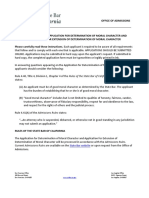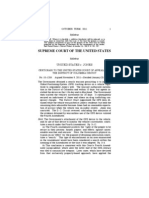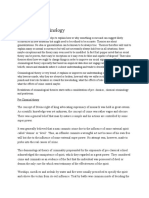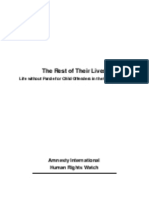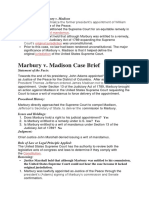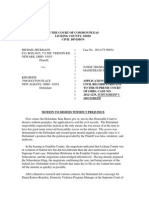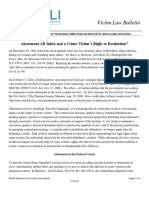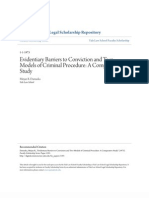The Insanity Defense
The Insanity Defense
Uploaded by
Dr. Celeste FabrieCopyright:
Available Formats
The Insanity Defense
The Insanity Defense
Uploaded by
Dr. Celeste FabrieCopyright
Available Formats
Share this document
Did you find this document useful?
Is this content inappropriate?
Copyright:
Available Formats
The Insanity Defense
The Insanity Defense
Uploaded by
Dr. Celeste FabrieCopyright:
Available Formats
The Insanity Defense
Dr. Celeste Fabrie Crime Studies
An important distinction: "Not guilty by reason of insanity" and "diminished capacity"
Although a defense known as "diminished capacity" bears some resemblance to the "reason of insanity" defense (in that both examine the mental competence of the defendant), there are important differences. The most fundamental of these is that, while "reason of insanity" is a full defense to a crime -- that is, pleading "reason of insanity" is the equivalent of pleading "not guilty" -- "diminished capacity" is merely pleading to a lesser crime. One of the most famous recent uses of the insanity defense came in United States v. Hinckley, concerning the assassination attempt against then-President Ronald Reagan.
The history of "not guilty by reason of insanity" The insanity defense reflects a compromise on the part of society and the law. On the one hand, society believes that criminals should be punished for their crimes; on the other hand, society believes that people who are ill should receive treatment for their illness. The insanity defense is the compromise: basically, it reflects society's belief that the law should not punish defendants who are mentally incapable of controlling their conduct. In the 18th century, the legal standards for the insanity defense were varied. Some courts looked to whether the defendant could distinguish between good and evil, while others asked whether the defendant "did not know what he did." By the 19th century, it was generally accepted that insanity was a question of fact, which was left to the jury to decide. The McNaughton rule -- not knowing right from wrong The first famous legal test for insanity came in 1843, in the McNaughton case. Englishman Daniel McNaughton shot and killed the secretary of the British Prime Minister, believing that the Prime Minister was conspiring against him. The court acquitted McNaughton "by reason of insanity," and he was placed in a mental institution for the rest of his life. However, the case caused a public uproar, and Queen Victoria ordered the court to develop a stricter test for insanity. The "McNaughton rule" was a standard to be applied by the jury, after hearing medical testimony from prosecution and defense experts. The rule created a presumption of sanity, unless the defense proved "at the time of committing the act, the accused was laboring under such a defect of reason, from disease of the mind, as not to know the nature and 2
quality of the act he was doing or, if he did know it, that he did not know what he was doing was wrong." The McNaughton rule became the standard for insanity in the United States and the United Kingdom, and is still the standard for insanity in almost half of the states. The Durham rule -- "irresistible impulse" Monte Durham was a 23-year-old who had been in and out of prison and mental institutions since he was 17. He was convicted for housebreaking in 1953, and his attorney appealed. Although the district court judge had ruled that Durham's attorneys had failed to prove he didn't know the difference between right and wrong, the federal appellate judge chose to use the case to reform the McNaughton rule. Citing leading psychiatrists and jurists of the day, the appellate judge stated that the McNaughton rule was based on "an entirely obsolete and misleading conception of the nature of insanity." He overturned Durham's conviction and established a new rule. The Durham rule states "that an accused is not criminally responsible if his unlawful act was the product of mental disease or mental defect." The Durham rule was eventually rejected by the federal courts, because it cast too broad a net. Alcoholics, compulsive gamblers, and drug addicts had successfully used the defense to defeat a wide variety of crimes. The Model Penal Code: turning responsibility to the jury In 1972, the American Law Institute, a panel of legal experts, developed a new rule for insanity as part of the Model Penal Code. This rule says that a defendant is not responsible for criminal conduct where (she) he, as a result of mental disease or defect, did not possess "substantial capacity either to appreciate the criminality of his conduct or to conform his conduct to the requirements of the law." This new rule was based on the District of Columbia Circuit's decision in the federal appellate case, United States v. Brawner, 471 F.2d 969 (1972). Obviously, this standard is very vague. It leaves a number of factors up to the jury to determine, given the facts of a case and the testimony of experts. About half the states have adopted the Model Penal Code rule for insanity. The Federal rule: Reagan gets into the act In 1984, Congress passed, and President Ronald Reagan signed, the Comprehensive Crime Control Act. The federal insanity defense now requires the defendant to prove, by "clear and convincing evidence," that "at the time of the commission of the acts constituting the offense, the defendant, as a result of a severe mental disease or defect, was unable to appreciate the nature and quality or the wrongfulness of his acts" (18 U.S.C. 17). This is generally viewed as a return to the "knowing right from wrong" standard. The Act also contained the Insanity Defense Reform Act of 1984, 18 U.S.C. 4241, which sets out sentencing and other provisions for dealing with offenders who are or have been suffering from a mental disease or defect.
You might also like
- Stage 2 History First ContactsDocument17 pagesStage 2 History First Contactsapi-250009981100% (1)
- Causal Research On Community Safety and The Criminal Justice SystemDocument7 pagesCausal Research On Community Safety and The Criminal Justice SystemArnold VenturesNo ratings yet
- Moral Character Determination Application InstructionsDocument11 pagesMoral Character Determination Application InstructionsAdam CohenNo ratings yet
- Exhibit B Affidavit Complaint Reckless Imprudence Resulting To Serious Physical InjuriesDocument3 pagesExhibit B Affidavit Complaint Reckless Imprudence Resulting To Serious Physical InjuriesErwin April Midsapak100% (3)
- Garcia DTODocument14 pagesGarcia DTOJeremy Schneider100% (1)
- Indiana Public Defense Task Force ReportDocument15 pagesIndiana Public Defense Task Force ReportIndiana Public Media NewsNo ratings yet
- Insanity PDFDocument16 pagesInsanity PDFPradinath Vinoth100% (1)
- Jurisprudence Course Outline (Document5 pagesJurisprudence Course Outline (Antara RanjanNo ratings yet
- United States v. JonesDocument34 pagesUnited States v. JonesDoug MataconisNo ratings yet
- Criminology - Theories of CrimeDocument11 pagesCriminology - Theories of CrimeAjay MaryaNo ratings yet
- COMPLAINT-AFFIDAVIT MUrderDocument4 pagesCOMPLAINT-AFFIDAVIT MUrderHarold B. Lacaba81% (26)
- Crime and Justice, Volume 46: Reinventing American Criminal JusticeFrom EverandCrime and Justice, Volume 46: Reinventing American Criminal JusticeNo ratings yet
- Insanity Defense GuidelinesDocument74 pagesInsanity Defense GuidelinesAde Kurnia SurawijayaNo ratings yet
- Private Prisons: A Bastion of SecrecyDocument27 pagesPrivate Prisons: A Bastion of SecrecyCREWNo ratings yet
- The Rest of Their Lives - Human Rights Watch - Juvenile Life Without Parole StudyDocument167 pagesThe Rest of Their Lives - Human Rights Watch - Juvenile Life Without Parole StudyTlecoz Huitzil100% (9)
- United States v. Dutton, 10th Cir. (2009)Document11 pagesUnited States v. Dutton, 10th Cir. (2009)Scribd Government DocsNo ratings yet
- Brady V Maryland RulingDocument13 pagesBrady V Maryland RulingJennifer WeaverNo ratings yet
- AQA Law A2 SampleDocument16 pagesAQA Law A2 SamplenhsajibNo ratings yet
- Mock TrialDocument12 pagesMock TrialAnshumaan PatroNo ratings yet
- Schizophrenia FinalDocument9 pagesSchizophrenia Finalapi-285384246No ratings yet
- Status Report On Collaborative Criminal Justice Efforts & Main Jail Rehabilitation ProjectDocument21 pagesStatus Report On Collaborative Criminal Justice Efforts & Main Jail Rehabilitation Projectgiana_magnoliNo ratings yet
- Exposing Fundamental Conlifcts Between Narco Analysis and The Self Incrimination DoctrineDocument14 pagesExposing Fundamental Conlifcts Between Narco Analysis and The Self Incrimination DoctrineGautam SwarupNo ratings yet
- Voluntary ManslaughterDocument16 pagesVoluntary ManslaughternasirapertoNo ratings yet
- Bench Memorandum: Reciprocal Discovery in Criminal CasesDocument33 pagesBench Memorandum: Reciprocal Discovery in Criminal CasesHon. William H. Burgess, III100% (2)
- A Synopsis For The Law Student On The Nature of Crime and The Criminal LawDocument15 pagesA Synopsis For The Law Student On The Nature of Crime and The Criminal LawIsikalu BiolaNo ratings yet
- Trial NotebookDocument98 pagesTrial Notebookaisat.biblanias203309No ratings yet
- The Grand JuryDocument336 pagesThe Grand Juryiamnumber8No ratings yet
- Case Summary of Marbury V MadisonDocument2 pagesCase Summary of Marbury V MadisonGilly Mae Gallego RPhNo ratings yet
- Cases, Criminal LawDocument197 pagesCases, Criminal Lawcarlo paduaNo ratings yet
- THE NEW MEXICO PROJECT An Analysis of The New Mexico Public Defense SystemDocument88 pagesTHE NEW MEXICO PROJECT An Analysis of The New Mexico Public Defense SystemAlbuquerque JournalNo ratings yet
- Criminal Justice Study Group Letter of RecommendationsDocument10 pagesCriminal Justice Study Group Letter of RecommendationsMike CasonNo ratings yet
- Penal CodeDocument7 pagesPenal Codesev gsdNo ratings yet
- Case ChartDocument14 pagesCase ChartKirstenP14No ratings yet
- Lawson v. Mabrie Lawsuit About Botched Funeral Service - October 2014Document9 pagesLawson v. Mabrie Lawsuit About Botched Funeral Service - October 2014cindy_georgeNo ratings yet
- Criminal Law SyllabusDocument7 pagesCriminal Law SyllabusgialightNo ratings yet
- Motion To Dismiss Application To SealDocument4 pagesMotion To Dismiss Application To SealKimBeemNo ratings yet
- Criminal Law OutlineDocument38 pagesCriminal Law OutlinelstadumNo ratings yet
- Commentary: A Broken Criminal Justice SystemDocument4 pagesCommentary: A Broken Criminal Justice SystemDavid IbanezNo ratings yet
- Abatement Ab Initio and A Crime Victims Right ToDocument4 pagesAbatement Ab Initio and A Crime Victims Right ToMista Man100% (1)
- CHAPTER 3 Clasification of LawDocument10 pagesCHAPTER 3 Clasification of LawNazatulJuhariNo ratings yet
- Unit 1 - Legal Reasoning, Analysis and WritingDocument86 pagesUnit 1 - Legal Reasoning, Analysis and WritingHiếu Vũ MinhNo ratings yet
- 11 Lawyers Held Guilty of Criminal Contempt, Sentenced To 3 Months in Jail by Allahabad High CourtDocument30 pages11 Lawyers Held Guilty of Criminal Contempt, Sentenced To 3 Months in Jail by Allahabad High CourtLive Law100% (1)
- JOHN SHERRILL - Ethics For Lawyers Representing Clients in MediationDocument14 pagesJOHN SHERRILL - Ethics For Lawyers Representing Clients in MediationIuliana EvaNo ratings yet
- Sentencing and Related MattersDocument11 pagesSentencing and Related MattersAwani PatelNo ratings yet
- Moot Court - AdvantagesDocument11 pagesMoot Court - AdvantagesAbhishek CharanNo ratings yet
- Mental Health Among Jail and Prison InmatesDocument10 pagesMental Health Among Jail and Prison InmatesdehamericoNo ratings yet
- Civil Courts and Constitutional IssuesDocument7 pagesCivil Courts and Constitutional IssuesAbdul Samad ShaikhNo ratings yet
- Chapter Vii Juvenile/Family ForensicsDocument9 pagesChapter Vii Juvenile/Family ForensicsjhoyNo ratings yet
- 13 Texas Law Enforcement Officers Amicus Brief For Rodney ReedDocument26 pages13 Texas Law Enforcement Officers Amicus Brief For Rodney ReedInjustice Watch100% (1)
- Evidentiary Barriers To Conviction (Damaska)Document85 pagesEvidentiary Barriers To Conviction (Damaska)Dalila SeoaneNo ratings yet
- Resource Guide For Managing Prisoner Civil Rights LitigationDocument183 pagesResource Guide For Managing Prisoner Civil Rights LitigationTania Dora Romero AramayoNo ratings yet
- HomicideDocument24 pagesHomicideremojamwa100% (1)
- How To Study and Answer Case Type QuestionsDocument4 pagesHow To Study and Answer Case Type QuestionsG MadhaviNo ratings yet
- Case StudiesDocument4 pagesCase StudiesmonsterbugsNo ratings yet
- Judicial Branch in A Flash ReadingsDocument2 pagesJudicial Branch in A Flash Readingsapi-261009456100% (1)
- Mike HestrinDocument4 pagesMike HestrinMike Hestrin Files100% (2)
- Civil Procedure OutlineDocument37 pagesCivil Procedure OutlinenicoleNo ratings yet
- ALE2 2020 Week 8 Legal Memo WritingDocument6 pagesALE2 2020 Week 8 Legal Memo WritingNgọc SangNo ratings yet
- Presumptions in Criminal CasesDocument19 pagesPresumptions in Criminal CasesDickson Tk Chuma Jr.100% (1)
- IdkDocument48 pagesIdkMike WilliamsNo ratings yet
- Judging Children As Children: A Proposal for a Juvenile Justice SystemFrom EverandJudging Children As Children: A Proposal for a Juvenile Justice SystemNo ratings yet
- Employees Wellness ProgramDocument6 pagesEmployees Wellness ProgramDr. Celeste Fabrie100% (3)
- The Psychology of Pyramid SchemesDocument9 pagesThe Psychology of Pyramid SchemesDr. Celeste FabrieNo ratings yet
- Histrionic Personality DisorderDocument3 pagesHistrionic Personality DisorderDr. Celeste Fabrie100% (3)
- Swiss Military - Juggling Army and Career" - What Makes The Swiss Tick?Document9 pagesSwiss Military - Juggling Army and Career" - What Makes The Swiss Tick?Dr. Celeste FabrieNo ratings yet
- Frustration - An Emotional Rollercoaster! "Following The Yellow Brick Road Phenomenon" - Wizard of OzDocument4 pagesFrustration - An Emotional Rollercoaster! "Following The Yellow Brick Road Phenomenon" - Wizard of OzDr. Celeste FabrieNo ratings yet
- Rechtsprache Englisch Exam 27.01.2012Document11 pagesRechtsprache Englisch Exam 27.01.2012Dr. Celeste FabrieNo ratings yet
- Me Tarzan. You Jane. Basta!Document6 pagesMe Tarzan. You Jane. Basta!Dr. Celeste Fabrie100% (1)
- Doctrine For The Armed Forces USA 2013 PDFDocument172 pagesDoctrine For The Armed Forces USA 2013 PDFDr. Celeste Fabrie100% (1)
- Felix The Flying Frog Parable Modern ManagementDocument3 pagesFelix The Flying Frog Parable Modern ManagementDr. Celeste FabrieNo ratings yet
- Gecs Chemicals SupplementDocument8 pagesGecs Chemicals SupplementDr. Celeste FabrieNo ratings yet
- Problem Solving in Autocratic VsDocument3 pagesProblem Solving in Autocratic VsDr. Celeste FabrieNo ratings yet
- Leaders Vs Managers Power-PointDocument18 pagesLeaders Vs Managers Power-PointDr. Celeste FabrieNo ratings yet
- Abraham Maslow's Hierarchy of NeedsDocument3 pagesAbraham Maslow's Hierarchy of NeedsDr. Celeste FabrieNo ratings yet
- Twilight of The GodsDocument1 pageTwilight of The GodsDr. Celeste FabrieNo ratings yet
- People V Guerrero, 2002Document5 pagesPeople V Guerrero, 2002Mae BernadetteNo ratings yet
- Habeas CorpusDocument67 pagesHabeas CorpusButch AmbataliNo ratings yet
- 01 Serapio v. SandiganbayanDocument3 pages01 Serapio v. SandiganbayanErwinRommelC.FuentesNo ratings yet
- An Examination of HomicideDocument45 pagesAn Examination of HomicideAlbi GashiNo ratings yet
- Bill - Student's ExampleDocument6 pagesBill - Student's ExampleAudrey Alleje FerrerNo ratings yet
- Cases FullDocument59 pagesCases FullLa AlvarezNo ratings yet
- Jurisdiction of Criminal Courts in Inquiry and TrialDocument4 pagesJurisdiction of Criminal Courts in Inquiry and TrialRupesh SapuiNo ratings yet
- People v. Dimaano 469 SCRA 647Document10 pagesPeople v. Dimaano 469 SCRA 647Delia PeabodyNo ratings yet
- Criminal Law OutlineDocument45 pagesCriminal Law OutlineEzekyle12No ratings yet
- PEOPLE V JUDGE INTING G.R. No. 88919Document3 pagesPEOPLE V JUDGE INTING G.R. No. 88919Christopher Ronn PagcoNo ratings yet
- The Science of Infanticide and Mental Illness: Velma Dobson and Bruce SalesDocument15 pagesThe Science of Infanticide and Mental Illness: Velma Dobson and Bruce SalesAlfa KaromahNo ratings yet
- Civil Law 2 Module 1 Case #012 - People vs. Abungan, G.R. No. 136843. September 28, 2000Document4 pagesCivil Law 2 Module 1 Case #012 - People vs. Abungan, G.R. No. 136843. September 28, 2000Ronald MedinaNo ratings yet
- Shaikh Zahid Mukhtar V State of MaharashtraDocument245 pagesShaikh Zahid Mukhtar V State of MaharashtraBar & BenchNo ratings yet
- Cyber Crimes. Pratap Full PaperDocument14 pagesCyber Crimes. Pratap Full PaperPratap C.ENo ratings yet
- Jurisdiction Class Notes PDFDocument4 pagesJurisdiction Class Notes PDFMatt LedesmaNo ratings yet
- FINAL LTI - Superseding Bail Application 12.17.2024Document25 pagesFINAL LTI - Superseding Bail Application 12.17.2024Matt Blac inc.100% (1)
- People Vs Angelo Trotter IV 7-2-041Document18 pagesPeople Vs Angelo Trotter IV 7-2-041rikwmun100% (1)
- Quezon CityDocument4 pagesQuezon CityPrincess Janine Sy100% (1)
- Valmonte V General de VillaDocument2 pagesValmonte V General de VillaViene Canlas100% (1)
- Jaharlal Das vs. State of OrissaDocument2 pagesJaharlal Das vs. State of OrissaNidhi PrakritiNo ratings yet
- Notice of Intent To File ClaimDocument3 pagesNotice of Intent To File ClaimThe State NewsNo ratings yet
- Physical InjuryDocument12 pagesPhysical InjuryRagasa janethNo ratings yet
- Huling Defensa Kuya TimbalDocument97 pagesHuling Defensa Kuya TimbalShanice Del RosarioNo ratings yet
- Actual MaliceDocument1 pageActual MaliceHazel-mae LabradaNo ratings yet
- 138 Sworn Statement N.I. ACT CHEQUESDocument4 pages138 Sworn Statement N.I. ACT CHEQUEShighcourtlegalfileNo ratings yet
- G.R. No. 96444Document4 pagesG.R. No. 96444AliyahDazaSandersNo ratings yet


